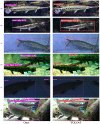A lightweight network model designed for alligator gar detection
- PMID: 38719910
- PMCID: PMC11078931
- DOI: 10.1038/s41598-024-61016-3
A lightweight network model designed for alligator gar detection
Abstract
When using advanced detection algorithms to monitor alligator gar in real-time in wild waters, the efficiency of existing detection algorithms is subject to certain limitations due to turbid water quality, poor underwater lighting conditions, and obstruction by other objects. In order to solve this problem, we developed a lightweight real-time detection network model called ARD-Net, from the perspective of reducing the amount of calculation and obtaining more feature map patterns. We introduced a cross-domain grid matching strategy to accelerate network convergence, and combined the involution operator and dual-channel attention mechanism to build a more lightweight feature extractor and multi-scale detection reasoning network module to enhance the network's response to different semantics. Compared with the yoloV5 baseline model, our method performs equivalently in terms of detection accuracy, but the model is smaller, the detection speed is increased by 1.48 times, When compared with the latest State-of-the-Art (SOTA) method, YOLOv8, our method demonstrates clear advantages in both detection efficiency and model size,and has good real-time performance. Additionally, we created a dataset of alligator gar images for training.
© 2024. The Author(s).
Conflict of interest statement
The authors declare no competing interests.
Figures

















Similar articles
-
FEB-YOLOv8: A multi-scale lightweight detection model for underwater object detection.PLoS One. 2024 Sep 27;19(9):e0311173. doi: 10.1371/journal.pone.0311173. eCollection 2024. PLoS One. 2024. PMID: 39331686 Free PMC article.
-
RSE-YOLOv8: An Algorithm for Underwater Biological Target Detection.Sensors (Basel). 2024 Sep 18;24(18):6030. doi: 10.3390/s24186030. Sensors (Basel). 2024. PMID: 39338779 Free PMC article.
-
Wheat Seed Detection and Counting Method Based on Improved YOLOv8 Model.Sensors (Basel). 2024 Mar 3;24(5):1654. doi: 10.3390/s24051654. Sensors (Basel). 2024. PMID: 38475189 Free PMC article.
-
Road damage detection algorithm for improved YOLOv5.Sci Rep. 2022 Sep 15;12(1):15523. doi: 10.1038/s41598-022-19674-8. Sci Rep. 2022. PMID: 36109568 Free PMC article.
-
YOLOv8-MU: An Improved YOLOv8 Underwater Detector Based on a Large Kernel Block and a Multi-Branch Reparameterization Module.Sensors (Basel). 2024 May 1;24(9):2905. doi: 10.3390/s24092905. Sensors (Basel). 2024. PMID: 38733010 Free PMC article.
References
-
- Lamson H, Cairns D, Shiao J-C, Iizuka Y, Tzeng W-N. American eel, Anguilla rostrata, growth in fresh and salt water: Implications for conservation and aquaculture. Fish. Manag. Ecol. 2009;16:306–314. doi: 10.1111/j.1365-2400.2009.00677.x. - DOI
-
- Liu SA. Landmark detection for distinctive feature-based speech recognition. J. Acoust. Soc. Am. 1996;100:3417–3430. doi: 10.1121/1.416983. - DOI
-
- Teutsch, M. & Kruger, W. Robust and fast detection of moving vehicles in aerial videos using sliding windows. In Proceedings of the IEEE Conference on Computer Vision and Pattern Recognition Workshops 26–34 (2015).
-
- Boykov Y, Funka-Lea G. Graph cuts and efficient ND image segmentation. Int. J. Comput. Vis. 2006;70:109–131. doi: 10.1007/s11263-006-7934-5. - DOI
-
- Iscen, A., Tolias, G., Avrithis, Y. & Chum, O. Label propagation for deep semi-supervised learning. In Proceedings of the IEEE/CVF Conference on Computer Vision and Pattern Recognition, 5070–5079 (2019).
Grants and funding
LinkOut - more resources
Full Text Sources

